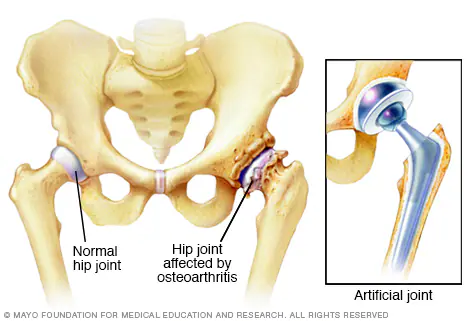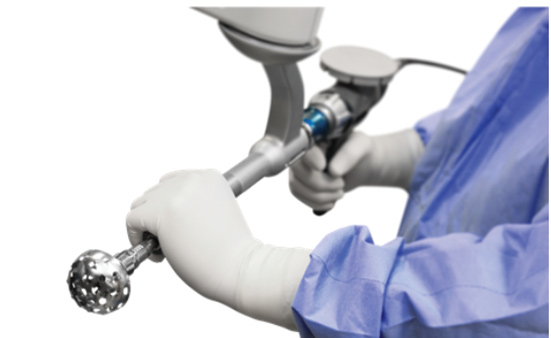Robotic HIP Replacement Surgery
Robotic hip replacement surgery involves the use of robotic technology, which assists orthopedic surgeons in planning and performing the surgery with greater accuracy. This approach can be employed for patients requiring total hip arthroplasty (THA) due to conditions like osteoarthritis, rheumatoid arthritis, or traumatic hip injuries.

How Hip Replacement Surgery is performed in Turkey?
Robotic hip replacement procedure is akin to a standard hip replacement. In this surgery, the surgeon extracts damaged tissue from the hip and substitutes it with an artificial joint. The key distinction is that this operation is assisted by a robotic arm, enhancing accuracy during the procedure.
Before surgery, a detailed imaging process is conducted to map out the joint that will be operated on. A specialized CAT scan is taken to create precise 3D images, which are then used by the surgeon to plan the procedure. These images take into account the unique structure of the bone, joint alignment, and surrounding tissues, allowing the surgeon to determine the best approach and choose the ideal implant size, location, and positioning.
On the day of surgery, tracking pins are placed on the knee and hip to help the robotic system, Mako, understand the anatomy. The Mako arm then uses these measurements to position itself, and the surgeon uses a robotic tool to guide them throughout the procedure. The Mako system acts as an assistant, not an autonomous surgeon, allowing for more accurate incisions and optimal implant placement.
What are the types of Hip Replacement Surgery in Turkey?
Who are suitable for Hip Replacement Surgery in Turkey?
Individuals who qualify for this surgery typically experience moderate to severe arthritis in the hip, including conditions such as osteoarthritis, rheumatoid arthritis, or post-traumatic arthritis, which lead to pain and hinder daily activities.
For instance:
Tasks like walking, climbing stairs, and bending to sit down or stand up become challenging.
Pain may be moderate to severe even at rest, potentially disrupting sleep.
Joint wear and tear can lead to stiffness that limits the hip's range of motion, resulting in a noticeable limp.
Non-surgical options, such as non-steroidal anti-inflammatory drugs (NSAIDs), physical therapy, steroid injections, or assistive devices like canes or walkers, do not provide sufficient relief.
Approximately 90% of those undergoing hip replacement surgery are affected by osteoarthritis. Additionally, some patients may require hip replacement to address issues related to fractures or other medical concerns, such as osteonecrosis, which involves bone death due to poor blood circulation.

What are the risks or side effects of Hip Replacement Surgery in Turkey?
Total hip replacement is considered a significant surgical procedure. While it is generally regarded as safe, like any surgery, it comes with potential risks. Some of the possible risks associated with the surgery include:
Blood Loss: There may be some bleeding during the procedure, which can lead to a need for blood transfusions in certain cases.
Nerve or Blood Vessel Injury: There is a small risk of injury to nerves or blood vessels surrounding the hip joint during the operation. This can result in complications such as numbness, weakness, or circulatory issues.
Fracture: There is a possibility of fracturing the pelvis or thighbone during the surgery, particularly if the bone is weakened due to arthritis or other conditions.
It is essential for patients to discuss these risks with their healthcare provider before undergoing the procedure to fully understand what to expect and to make an informed decision.
How long does it take to recover from Hip Replacement Surgery in Turkey?
After a total hip replacement, rehabilitation typically commences within 24 hours following the surgery. In most cases, patients are able to begin walking with support from devices such as a cane, walker, or crutches just one to two days post-op. The focus during the early days of recovery is on gradually enhancing mobility and regaining strength.
As you progress, you’ll likely increase your walking distance and the frequency of your walks. It's important to listen to your body and follow any specific guidance from your rehabilitation team.
The overall recovery period can vary widely, generally taking anywhere from two to eight weeks. Individual factors, such as age, baseline health, the specific surgical approach used, and commitment to physical therapy, can all influence recovery time. Engaging in regular follow-up appointments is vital to assess your healing and adapt your rehabilitation plan as needed to ensure optimal recovery.

What is the ideal age for Hip Replacement Surgery in Turkey?
While total hip replacements are commonly performed on individuals between the ages of 60 and 80, they are not limited to this age range. In fact, this surgical option can be suitable for patients of various ages, including:
Teenagers: For severe hip dysplasia or other conditions, hip replacement surgery may be necessary to restore mobility and alleviate pain.
Young adults: Those with hip injuries, such as fractures or osteonecrosis, may require hip replacement surgery to regain function and mobility.
Elderly patients: Older adults may benefit from hip replacement surgery if they experience severe arthritis, osteoporosis, or other conditions that impair their quality of life.
Ultimately, the decision to undergo hip replacement surgery depends on individual circumstances, including the patient's overall health, activity level, and the severity of their condition. Consultation with an orthopedic specialist is necessary to determine the best course of treatment.
What to expect after Hip Replacement Surgery in Turkey?
After Surgery
Post-surgery, it’s normal to experience some discomfort; however, pain management options will be provided to help alleviate it. You may have a drainage tube placed to collect any excess blood that might accumulate around your hip. To reduce the risk of blood clots, your doctor may prescribe blood thinners.
Day After Surgery
The focus shifts to mobilizing your new hip joint. A physical therapist will guide you through specific exercises designed to strengthen the surrounding muscles. You’ll likely be assisted in sitting up at the edge of your bed, standing, and beginning to walk. If your surgery is carried out early in the day and everything goes as planned, you might even have the opportunity to initiate physical therapy that same afternoon.
1-2 Days After Surgery
You’ll continue to engage in exercises and may start walking with the assistance of crutches or a walker. As your pain subsides, your care team may transition you from IV pain management to oral medications. By this point, you should also be able to consume a regular diet, moving away from the liquid-only meals you had initially.
4 Days After Surgery
At this stage, it's crucial to take special care of your incision site. Keep it dry and avoid applying creams, lotions, or ointments. You can help manage pain by using an ice pack on the area for 10-15 minutes at a time. Make sure to continue the exercises you learned at the hospital to promote mobility and healing.
3-6 Weeks After Surgery
Most patients are able to return to many light daily activities during this period. However, some discomfort or soreness may linger, especially toward the end of the day. By the six-week mark, you should feel ready to resume driving.
10-12 Weeks After Surgery
By now, you should start feeling more like yourself. Most of your initial pain will likely have subsided, and any swelling should be considerably reduced. Moving around will feel easier, and you'll probably be able to engage in many of your regular activities—whether it's gardening, dancing, or taking longer walks. You’ll also have follow-up appointments with your doctor throughout the first year to ensure a successful recovery and monitor the progress of your new hip.
How much does it cost to have Hip Replacement Surgery in Turkey?
Hip Replacement Surgery is a widely sought-after procedure in Turkey, attributed to the country's high-quality medical services and affordability. The cost of Hip Replacement Surgery in Turkey can vary based on several factors, including the surgeon's experience, the clinic's reputation, the complexity of the procedure, and the services provided. On average, prices typically range from €10.000 to €15,000.
| Country | Average Cost (USD) | Remarks |
|---|---|---|
 Turkey Turkey |
$12,000 - $16,000 | Affordable with comprehensive packages |
 USA USA |
$30,000 - $50,000 | Higher cost, advanced facilities |
 UK UK |
$18,000 - $25,000 | High quality, more expensive |
Why choose Elan to have Hip Replacement Surgery in Turkey?
At Elan, we understand the importance of providing exceptional care and support to our clients throughout their medical travel journey. When you choose Elan for Facelift, you can expect,
Access to renowned and experienced surgeons who specialize in Facial Plastic Surgeries.
State-of-the-art medical facilities equipped with advanced technology.
Personalized assistance with travel arrangements, accommodation, and post-operative care.
Affordable and transparent pricing options.
A dedicated team committed to ensuring your comfort, safety, and satisfaction.
Quick facts of Hip Replacement Surgery in Turkey
- Procedure: Replacing damaged hip components with an artificial joint.
- Duration: 1 to 2 hours
- Stay: 3-4 night Hospital 6-7 nights Hotel Accomodation.
- Anesthesia: General Anesthesia
- Recovery: After 2-4 weeks can go back to work
- Clothes to Wear: Comfortable clothes (sweatshirts, button-down or zipped shirt etc.)
- Side Effects: Clicking or popping, Loosening, Nerve damage, Swelling and stiffness
- Exercise: After 3-4 months
- Scars: Small vertical scar
- Pain: Mild
- Results: Swelling will go ease after 7 to 15 days and final result reveal between 6 months to 1 year
